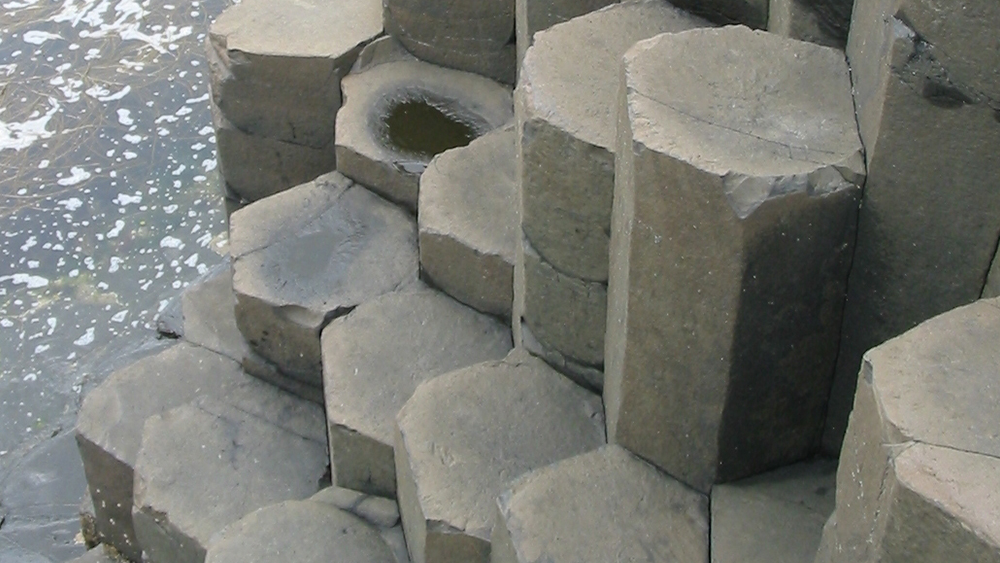In nature, noncoincidental patterns and geometry exist everywhere. But the number six appears to overshadow nature’s mathematical landscape. Whether in beehives, rock formations, or insect eyes, the number six, specifically hexagonal geometry, stands front and center. Could this just be a mathematical coincidence, or is there something more to this widespread hexagonal geometry?
Hexagonal Geometry: How and Why?
Soap bubbles provide a simple, but excellent, illustration of how this underlying hexagonal property is revealed. A bubble is just some volume of gas surrounded by liquid, but it has a clear shape. Liquid molecules reach maximum stability when the attraction is balanced. This pushes liquids to adopt shapes with the least surface. In zero gravity, this attraction pulls water into round shapes. Inside thin soap films, the attraction between soap molecules shrinks the bubble until the pull of surface tension is balanced by the air pressure pushing out. Bubbles are round because a sphere is the most efficient shape to enclose the maximum volume with the least surface area.1
So, what happens when one packs bubbles together on a surface? A sphere is a three-dimensional shape, but the cross-section is a circle. Rigid circles of equal diameter can cover, at most, 90% of the area on a plane. But bubbles aren’t rigid. When two equal-size bubbles coalesce, a flat intersection manifests between them. When three coalesce, walls meet at 120Ëš.
For four bubbles, instead of a square intersection, the bubbles will always rearrange themselves so that their intersections are 120Ëš, the same angle that defines a hexagon. This arrangement minimizes the perimeter for a given area.2 In fact, in the late 19th century, Belgian physicist Joseph Plateau calculated that 120Ëš junctions are also the most mechanically stable arrangement; the forces on the films are all in balance.3 Not only does this arrangement minimize the perimeter, but the pull of surface tension in each direction is also the most mechanically stable.
Hexagonal Geometry in Nature
This hexagonal packing is exhibited in many places in nature. For example, basalt columns like the Giant’s Causeway in Ireland; some at Devils Tower in Wyoming, USA; and the Plains of Catan in Sicily form from rapidly cooling lava. Cooling contracts the lava surface to fill less space, just like surface tension pulls on soap film. Cracks form to release tension and to reach mechanical stability, and more energy is released per crack if they meet at 120Ëš. These surface cracks then propagate downward as the lava cools, making vertical hexagon-shape columns. The forces are different when comparing bubble packing to basalt column formation, but similar math is used to solve similar problems.4
Another example is the facet of an insect’s eye. Instead of a physical force, like in the bubble or basalt columns, the driver for the utilization of hexagonal geometry is the maximum light-sensing area. Pigment cells line the outside margins of each ommatidium. Each pigment cell influences three joining hexagonal ommatidia, where it absorbs and directs specific angles of light entering each of them. Each respective pigment-ommatidial arrangement acquires a fraction of specific focal targets within the available visual field. This hexagonal shape not only optimizes light sensing but also minimizes the amount of cell material around the edges. And when looking down at the bottom of each facet, there’s a cluster of four cone cells that are hexagonally packed, just like bubbles.5
Hexagonal geometry can even help explain a honeycomb. Honeybees first make round wax cells. As the wax is softened by heat from bees, it’s pulled by surface tension into stable hexagonal shapes, like the hexagonal bubble formation discussed earlier.6 This geometry makes honeycombs stronger, with each hexagonal cell making complete contact on each side with other hexagons in the comb. Thus, there’s no wasted space or underutilization of wax construction materials.7
Hexagonal Geometry: Random or Designed?
Evolutionists theorize that the universe came into being by random means. Randomness inherently lacks symmetry, as the concept of symmetry implies order. Quite simply, randomness lacks any evidence of design because if design is demonstrated to any degree, that would imply it’s no longer random. Nature, on the contrary, doesn’t display randomness. In reality, as evidenced by the number six, nature exhibits quite the opposite. Ultimately, hexagonal geometry is exhibited in beehives, rock formations, turtle shells, and insect eyes because the same perfect Designer designed them all in perfect proportion, unison, and harmony.
Although this world is fallen and subject to futility (Genesis 3), evidence of design is everywhere we look. Some of the most remarkable findings of modern physics, cosmology, and botany—especially the indications that our universe and its laws seem remarkably tailored to sustain life—support this point of view.
References
-
Zare, R. N. 2005. Bursting Bubbles. The Nucleus. 83: 9-10. https://web.stanford.edu/group/Zarelab/p
ublinks/747.pdf -
Andrei, M. The hexagon shape and why it shows up so much in nature. ZME Science. Posted on zmescience.com September 18, 2021. https://www.zmescience.com/other/feature
-post/hexagon-shape-nature-physics-13092
021/ - Ball, P. 2009. Shapes. Nature’s patterns: A tapestry in three parts. Oxford: Oxford University Press, 68.
- Spry, A. 1962. The origin of columnar jointing, particularly in basalt flows. Journal of the Geological Society of Australia. 8 (2): 192-216.
-
Sangwoo, K. et al. 2016. Hexagonal Patterning of the Insect Compound Eye: Facet Area Variation, Defects, and Disorder. Biophysics Journal. 111 (12): 2735-2746. https://www.ncbi.nlm.nih.gov/pmc/article
s/PMC5194618/ - Andrei, The hexagon shape and why it shows up so much in nature.
- Moon, I. A. 1962. City of the Bees. Chicago, IL: Moody Institute of Science. DVD Version 1998.














